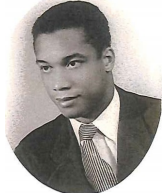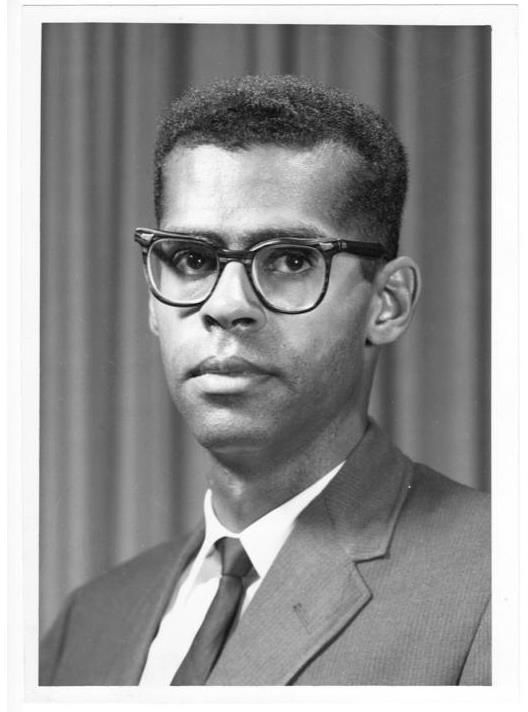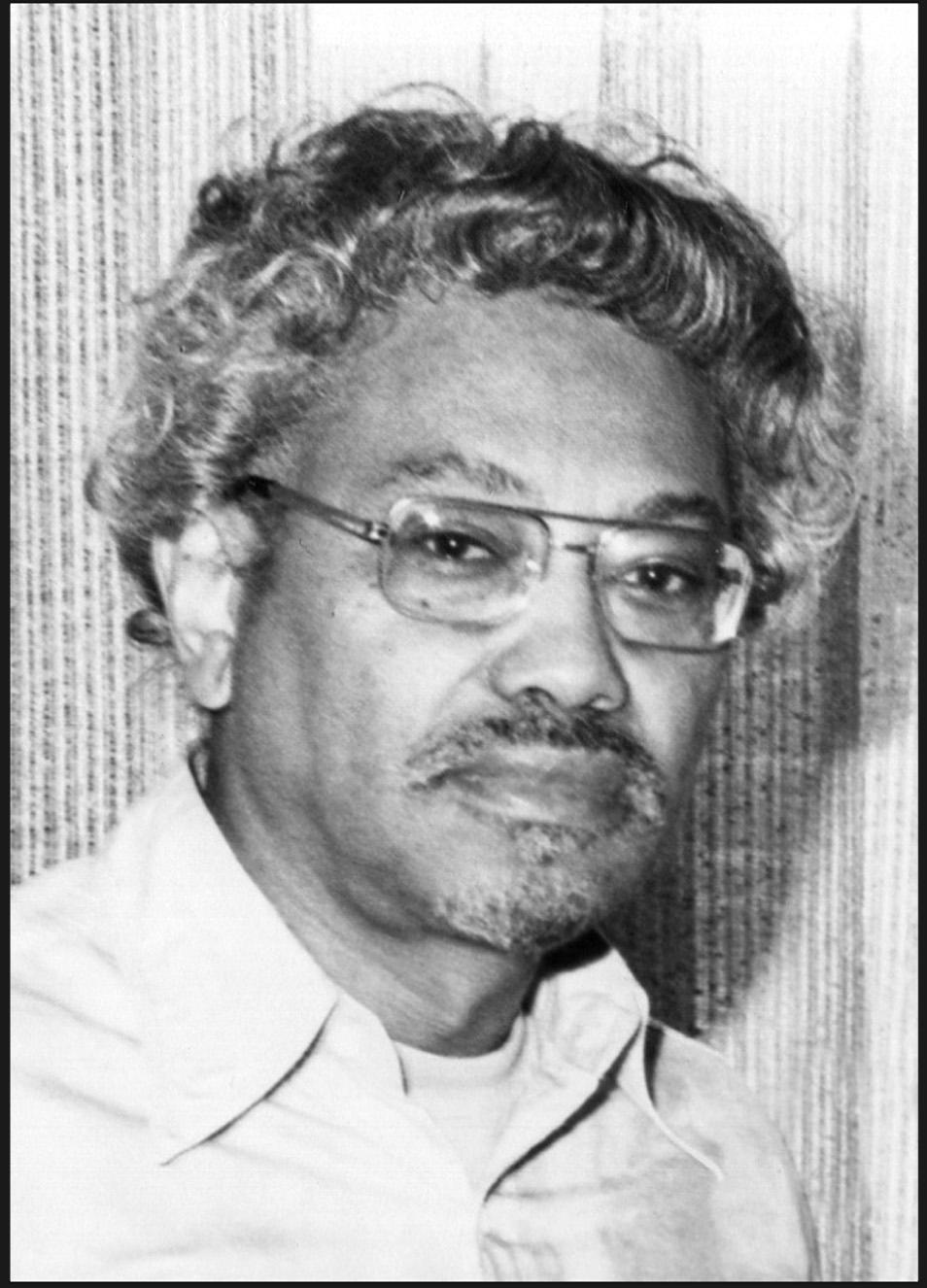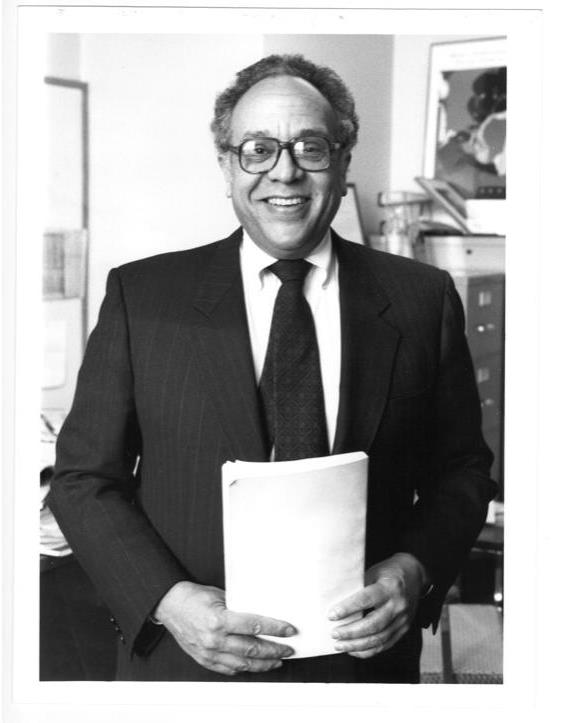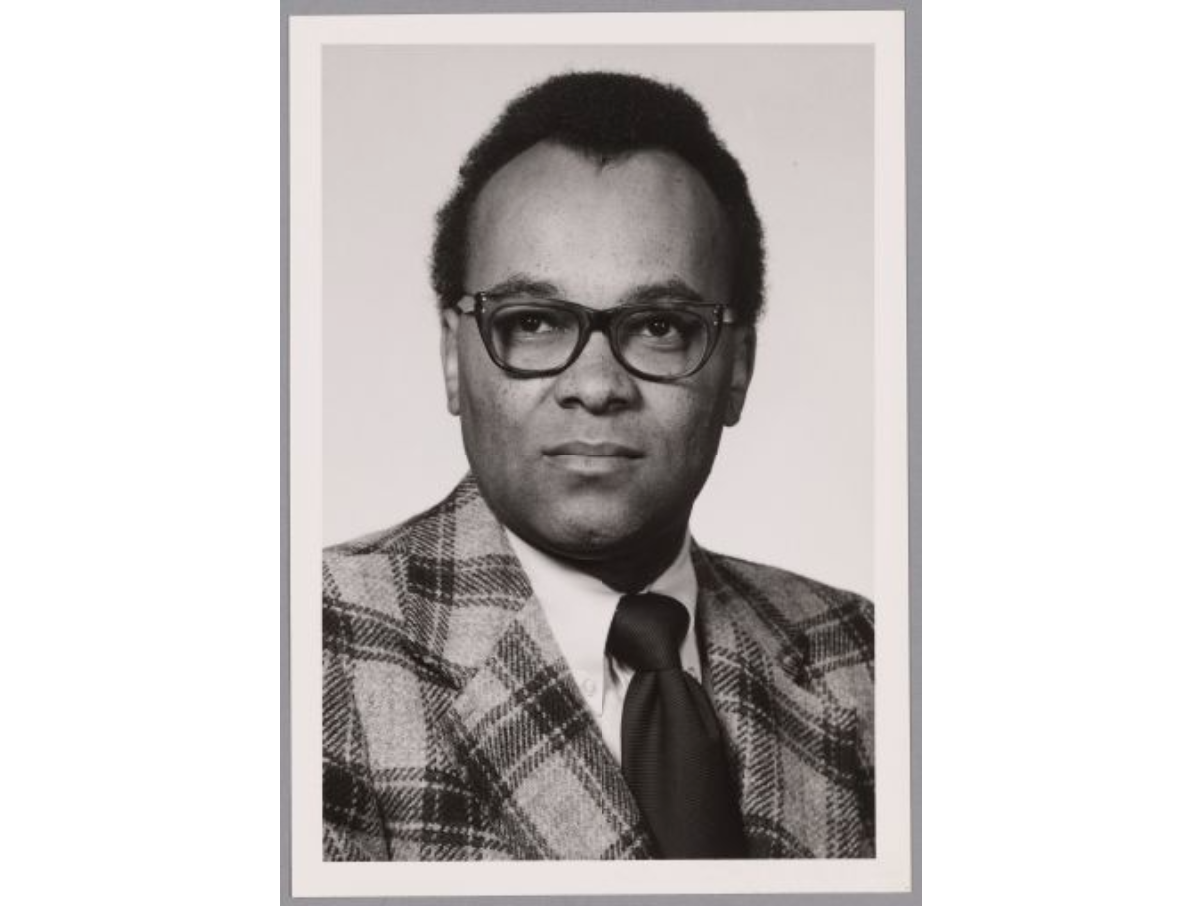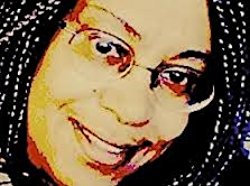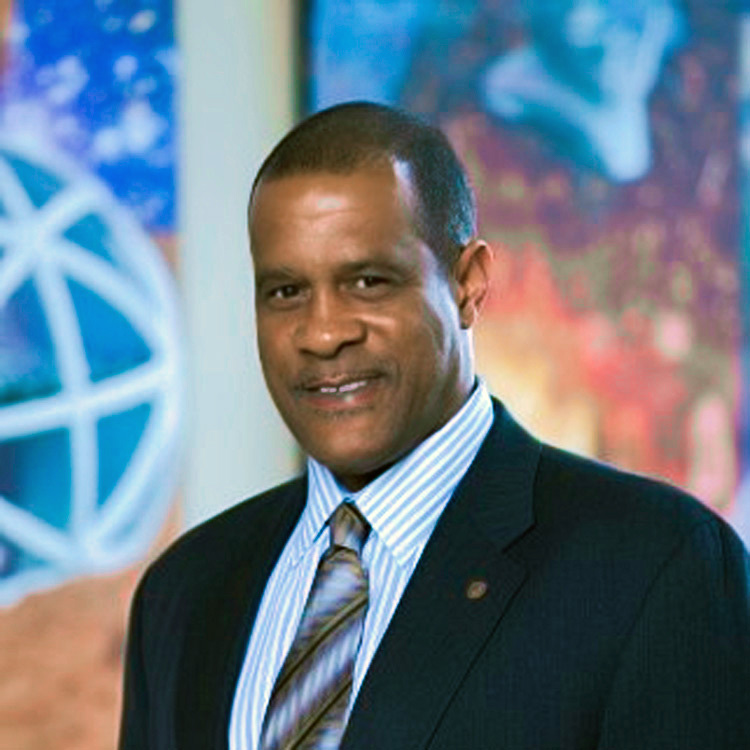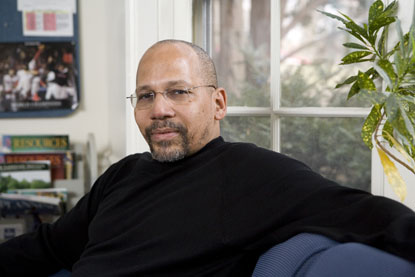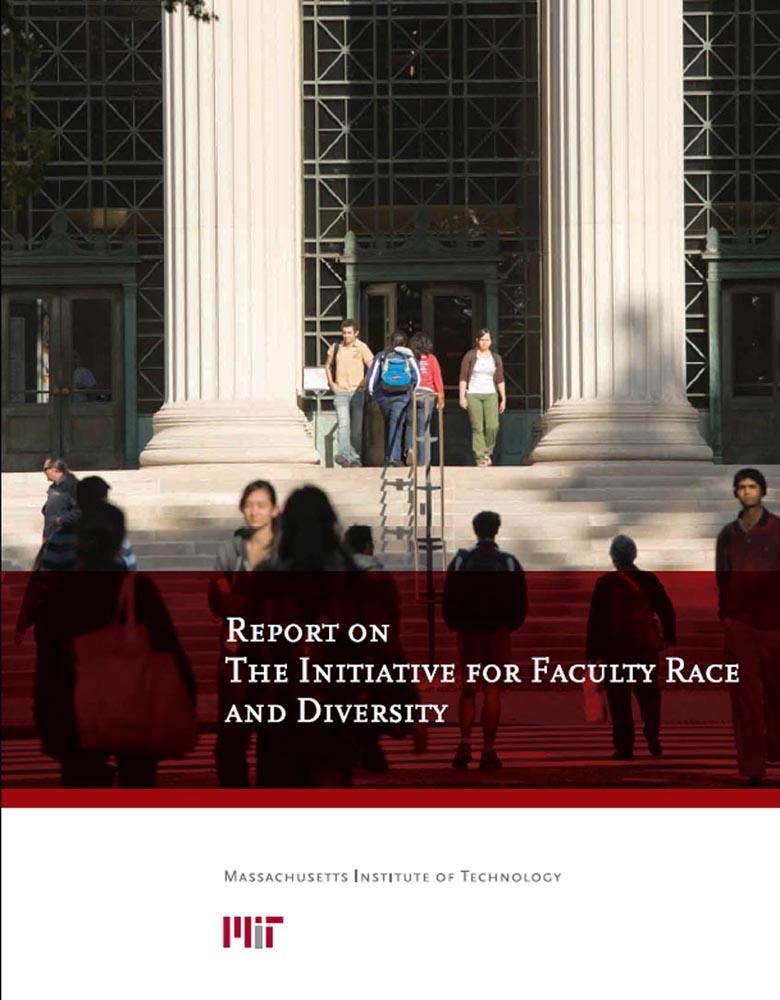Some argue that the small numbers of black doctoral candidates in STEM fields pose unique faculty diversity recruitment challenges for MIT. Others concede that MIT nevertheless appears to have a "far superior” record of black faculty hiring than other top science and engineering colleges like California Institute of Technology.
Time will tell whether MIT's commitment to faculty diversity will bear fruit. Clearly [MIT] believes that successful affirmative action in faculty hiring will not undermine the academic quality or standing of the institution. Instead it will enhance [MIT's] position in a multicultural world.
"The Serious Search for Black Faculty at MIT," Journal of Blacks in Higher Education, 1995
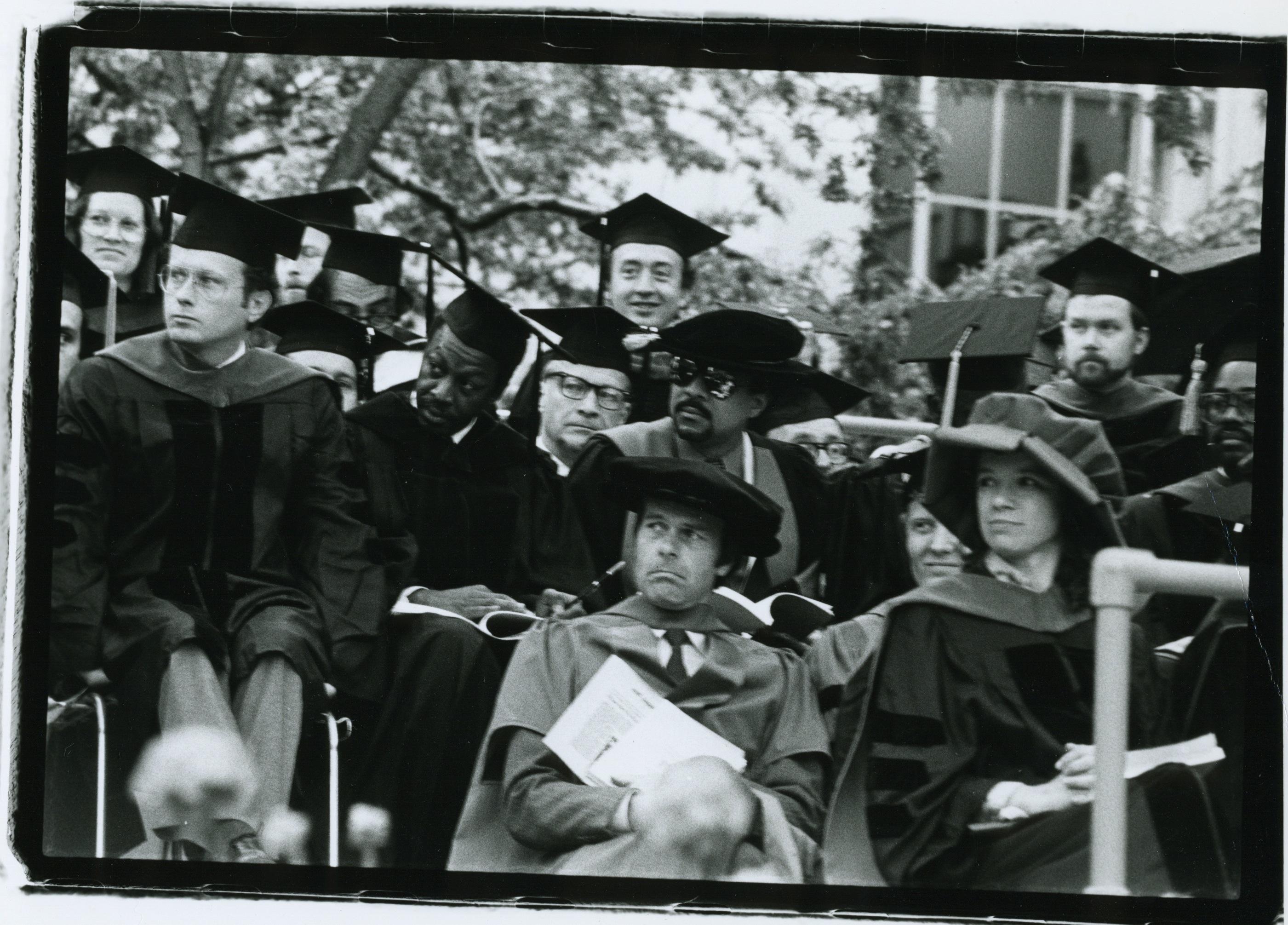
Faculty at Commencement, June 1984. Middle, 2nd and 3rd from left: Clarence G. Williams, then Special Assistant to the President and Institute Ombudsperson, and mechanical engineering professor James H. Williams, Jr.
Ellen Swallow Richards - 1884
The Institute's appointment of white alumna Ellen Swallow Richards '73 might be considered MIT's first "minority appointment". Richards, also the first woman student admitted to MIT, served as an instructor in sanitary chemistry from 1884 until her death in 1911. She created the first sanitary engineering laboratory in the United States. Booker T. Washington sought her advice on curriculum development and on staff recruitment for Tuskegee Institute.
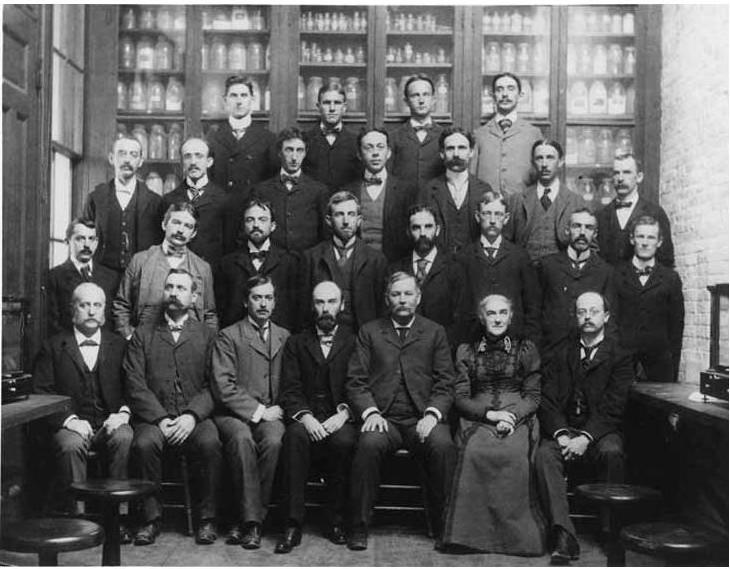
Ellen Swallow Richards '73 (first row, 2nd from right), instructor in sanitary chemistry, with MIT Chemistry staff, 1900.
MIT's first known black non-tenure appointments were made over 60 years after Richards' appointment and nearly a century after the Institute first opened its doors.
Lionel Salgado - 1949
Although there were no black faculty members prior to 1956, MIT did have a French instructor on a staff appointment during the 1949-50 academic year. Haitian-born Lionel Justin Salgado was recommended for the position by George E. Condoyannis of the Modern Languages Department. Salgado taught elementary French aimed at enabling the students to read technical articles in foreign publications. Deemed an outstanding teacher by department head William N. Locke, Salgado's contract was extended for a second semester. However, he resigned and left Cambridge for reasons that remain a mystery.
In an unusual turn of history, today Professor of Linguistics Michel DeGraff continues Salgado's work with language at MIT--albeit in Kreyòl rather than French. DeGraff is Director of the MIT-Haiti Initiative, which promotes active learning and use by faculty and students of their native Kreyòl for STEM disciplines in Haiti’s schools.
Joseph Applegate - 1956
As far as can be determined, linguist Joseph Roye Applegate was the first appointed black faculty member at MIT. While there had been a handful of African-Americans in professional staff positions at the Institute prior to that time, none had achieved faculty rank. Practically all of MIT's black employees were service staff-waiters, porters, cleaners, groundsmen and dormitory crew.
Applegate was considered an expert in the Berber language of southwestern Morocco. In 1955, he joined the MIT Research Laboratory of Electronics (RLE) as faculty to work on machine translation and mathematical studies of grammar. Other linguists at the RLE included Noam Chomsky--both Chomsky and Applegate earned doctorates from the University of Pennsylvania in 1955.
Everyone was working on something significant, so there was no reason to hold back...as a member of the [MIT] faculty, I don't think there was any hesitation about acceptance. Certainly in the research laboratory of electronics.
Joseph Applegate in Technology and the Dream, 1996
From 1956 to 1960, Applegate served as Assistant Professor of Modern Languages at MIT, teaching courses that included German and intermediate and advanced subjects in "English for Foreign Students". In 1959, he became Director of MIT's new language laboratory. By 1960, however, the mechanical translation project had not progressed, and Applegate left MIT. His subsequent career took him to UCLA and Howard University, where he directed the African Studies and Research Program.
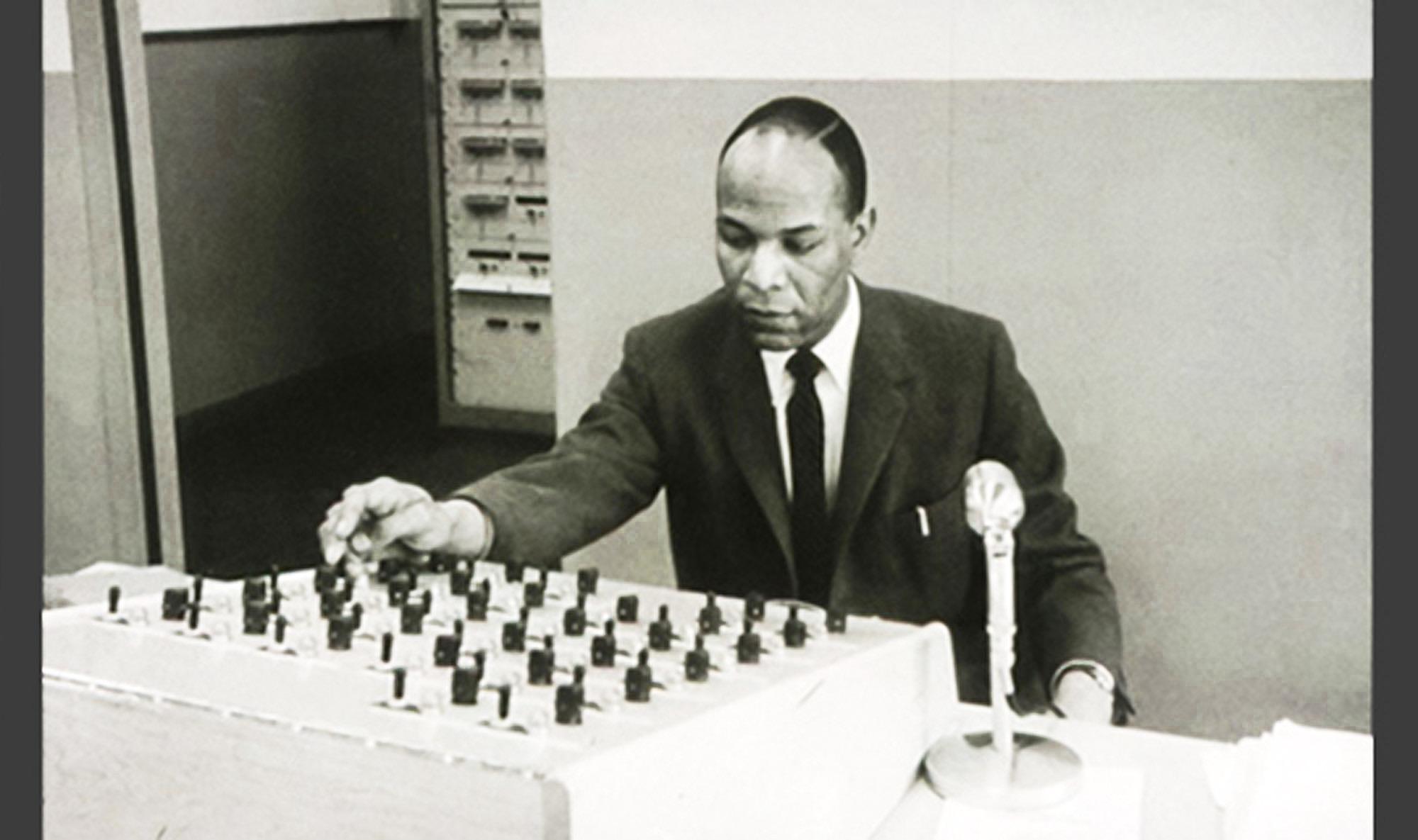
Joseph Applegate and the "Linguatrainer," Spring 1959
Ronald McLaughlin - 1962
Following Joseph R. Applegate, the next black faculty member appointed at MIT was Canadian-born Ronald Theodore McLaughlin. In 1962, he was one of the civil engineering department's first appointments in the field of water resources systems as opposed to the then prevalent emphasis on hydraulic engineering. Much of the environmental work he did during this time was later recognized to be innovative as alternative technologies for handling wastewater in rural areas gained prominence.
At MIT, McLaughlin developed Environmental Water Systems (ENWATS), a consulting firm with a focus on international civil engineering projects mostly in Brazil and Colombia. Courses he taught at the Institute included hydraulic engineering, water resources development, water quality control, and water resource systems. In his short career at MIT, McLaughlin directed a total of 23 theses presented for advanced degrees--18 masters and 5 doctoral.
Ron was one of the hardest working professors I have ever known. He was known to get by on four hours sleep every night...He was an absolute perfectionist...
Frank E. Perkins, MIT colleague, 1997
McLaughlin also devoted considerable time and effort on strategies to broaden MIT's role within the wider community, including the MIT Summer Day Camp in Science and Technology, which attempted to provide a novel educational experience for underprivileged youth in local neighborhoods. McLaughlin was promoted to associate professor in 1965, but took a leave of absence three years later, remaining on leave until his resignation from MIT in 1969.
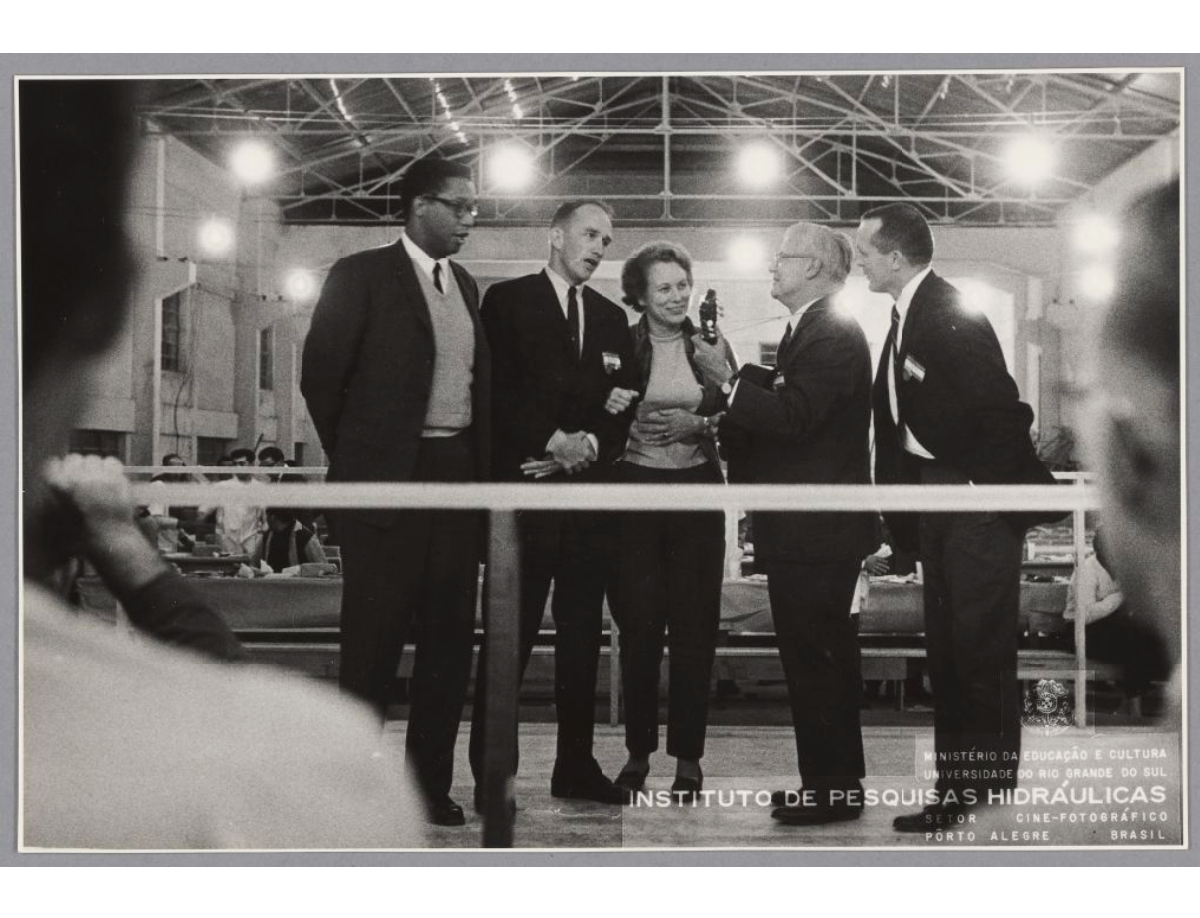
Arthur T. Ippen (2nd from right) singing American folk songs and playing guitar beside his wife Ruth Ippen, alongside (left to right) MIT professors Ronald T. McLaughlin, John Fisher Kennedy, and Peter S. Eagleson. Ministry of Education and Culture, University of Rio Grand Do Sul's Institute of Hydraulic Surveys [Ministerio Da Educada E Cultura, Universidade Do Rio Grande Do Sul, Institutio De Pesquias Hidraulicas Setor Cine-Fotografic]. Porto Alegre, Brazil, 12 August 1964.
Willard Johnson - 1964
Willard Raymond Johnson was the only other black professor during Ronald T. McLaughlin's time at the Institute. Johnson joined the Department of Political Science in 1964 and is currently Professor of Political Science Emeritus.
Over the course of his long career at MIT, Johnson's research has covered a broad range of African and African American studies--from the politics, policy strategies, and role of external human and capital resources in African development, to aspects of African and African American history, culture, philosophy, and inter-ethnic and foreign relations. Johnson founded and continues to be active in the leadership of both The Boston Pan-African Forum and The Kansas Institute of African American and Native American Family History (KIAANAFH).
The 1970s saw the first tenure appointments of black faculty members, among them a woman professor.
James Edward Young - 1970
The MIT career span of James E. Young MS '51, Ph.D. '53 overlaps with that of Frank S. Jones (see below). Like Jones, Young made history in 1970 as his department's first black tenured faculty members; both held their posts until 1992, before becoming emeriti professors.
Young graduated from Howard University with a bachelor's in physics in 1946. From 1946 to 1949 he taught physics at Hampton Institute in Virginia. He simultaneously worked on a masters degree in physics at Howard University, in absentia, before joining the staff of the Acoustics Laboratory at MIT as Research Assistant in 1949.
Young received his MS degree, without specification, from MIT. He stayed on to earn his Ph.D. in Physics in 1953, with a dissertation entitled "Propagation of Sound In Attenuating Ducts Containing Absorptive Strips," and completed a one-year Postdoctoral Fellow in Acoustics in 1954. He returned to the Institute in 1969 as a Visiting Professor, earning tenure the following year in the Department of Physics.
One of the most interesting persons at the [MIT Center for Theoretical Physics] was James Young...our discussions would often turn to the senior physicists in the black college community who mentored several generations of students who then went on to achieve doctorates in physics. These "elders" served as role models, provided the required intellectual tools for success in graduate school, and gave (when needed) both emotional and financial support to their students.
Physicist and MIT Visiting Professor Ronald E. Mickens, 1999
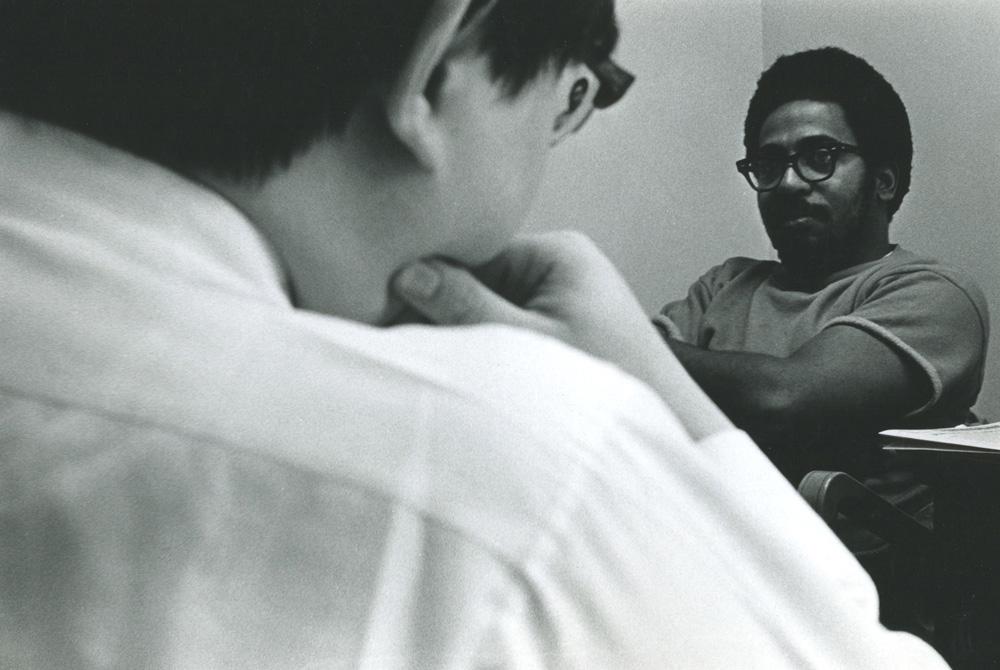
Ronald E. Mickens (right), MIT visiting professor in physics, 1974.
As a founding member of the National Society of Black Physicists (along with Ronald Mickens and other black physicists), Young is well-known for mentoring two pioneering and exceptionally promising MIT doctoral students: Shirley Ann Jackson '68, Ph.D. '73 and Sylvester James Gates, Jr. '73, Ph.D. '77. Both would go on to distinguished careers in physics and academia, including appointments by two U.S. presidents.
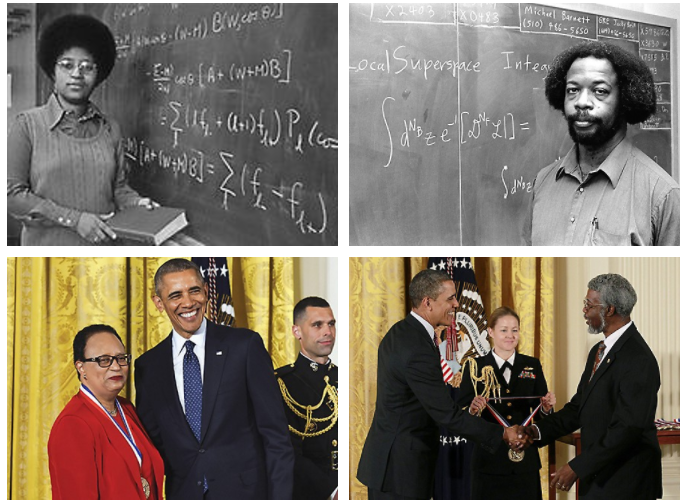
Images: Courtesy MIT Museum (top left); AIP Emilio Segrè Visual Archives, Ronald E. Mickens Collection (top right); Associated Press (bottom)
Frank Jones - 1970
Frank Sidney Jones was the son of a Bennett College president. Jones came to MIT with an MBA from Harvard, having previously served as Assistant Dean of the Harvard Business School. When MIT President Howard W. Johnson offered him a job as assistant to the president at the Institute, Jones refused. Instead, he accepted the position of director of the Urban Systems Laboratory, serving from 1968 to 1969. He made history in 1970 as the Institute's first African-American tenured faculty. As the Jones Ford Professor of Urban Affairs and Planning in the Department of Urban Studies and Planning (DUSP) he taught courses in civil engineering.
At the time, DUSP was capitalizing on the nation's climate of urgency about solving urban problems. Jones was also appointed the director of the Whitney Young Program (a precursor to the Community Fellows Program). This non-degree program enabled a selected group of local leaders to spend the equivalent of an academic year at MIT working with faculty on projects of special importance to them and to their organizations or communities.
Look, as long as you're clear about what you want to get done in academia, the academic base can be useful as a resource space to get certain things done in the city...
Frank Jones advising MIT colleague Herbert Jones, professors in urban studies and planning, Technology and the Dream
Jones founded Project Technology, Race and Poverty, which he directed from 1970 to 1973. He served on a committee to urge MIT to found the Office of Minority Education (OME) in 1974 with the aim of recruiting and retaining minority students. Today the Frank S. Jones Student Activity Fund supports students working on community-based projects and activities in the Department of Urban Studies and Planning.
Hubert Jones - 1974
Hubert "Hubie" Eugene Jones joined the DUSP faculty as Associate Professor and Head of the Community Fellows Program in 1974. By then, however, the cost of increases and funding cuts began to affect DUSP's projects and research efforts. The department encouraged faculty to devote more time to sponsored research and initiated new contacts with the private sector. In 1977, three years after joining DUSP, Jones left MIT to become the first black dean of Boston University's School of Social Work, a post he held from until 1993.
Phyllis Wallace - 1975
Labor economist and activist Phyllis A. Wallace was key to the anti-workplace-discrimination contingencies of the 1964 Civil Rights Act. She joined the MIT Sloan School of Management as a visiting professor in 1973. Former Sloan Dean and MIT President Howard W. Johnson had recruited Wallace from Yale University, where she had already made history as the first woman to earn a Ph.D. in economics (1948), as well as her Masters (1944).
Wallace's research spearheaded a precedent-setting legal decision in a federal case that reversed sex and race discrimination in American industry. She directed studies for a federal lawsuit against AT&T, then the largest private employer in the U.S. The suit led to a 1973 decision that the company had discriminated against women and minority men. AT&T agreed to pay millions in back wages and to make other pay adjustments. The verdict also brought about changes in transfer and promotion policies and recruitment criteria. Wallace wrote about the case in her book, Equal Employment Opportunity and the AT&T Case (MIT Press, 1976). Her promotion to full professor in 1975 made Wallace the first woman to gain tenure at Sloan.
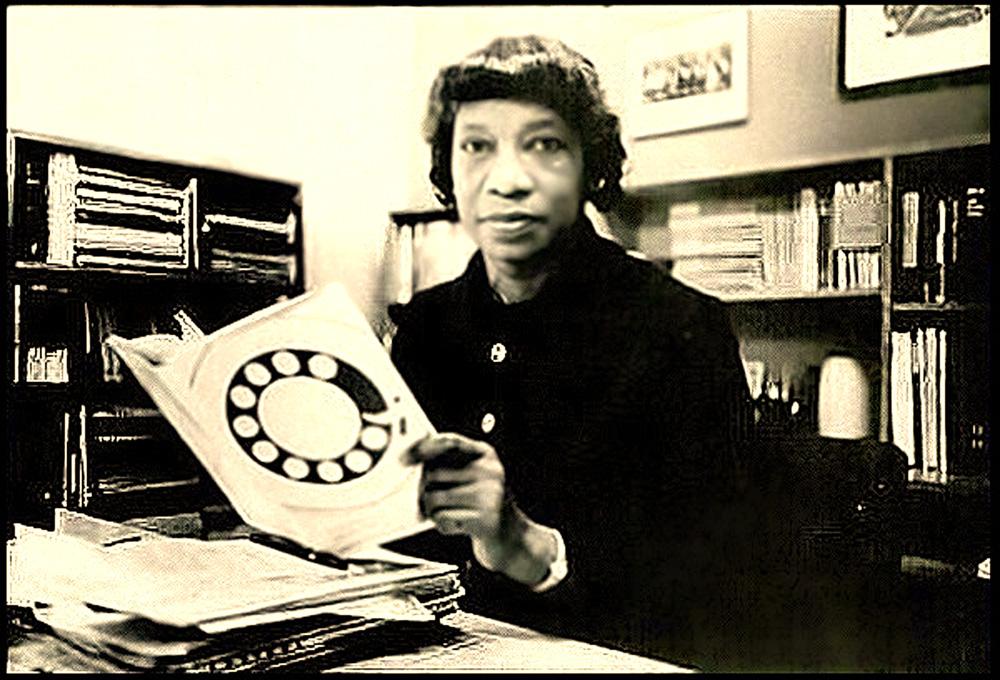
Phyllis Wallace shown holding her newly published book, Equal Employment Opportunity and the AT&T Case, 1976.
Chester Seabury - 1970s
Chester C. Seabury earned a Ph.D. from Stanford University in 1974. After unsatisfying years as an Assistant Professor of Mathematics at MIT, he went back to school at Stanford in 1977 and earned both a law degree and an MBA.
The assassination of Martin Luther King, Jr. in 1968 sparked student demands for new initiatives towards making MIT a more equitable community. Institute responses throughout the 1970s included a Task Force on Educational Opportunity, minority student programs, and appointments of black administrators.
SPECIAL ASSISTANT TO THE PRESIDENT - 1970s
In 1972, the Institute hired an Assistant Dean of the Graduate School charged with spearheading the MIT’s effort to increase the number and retention of minority graduate students in all 23 departments. Clarence G. Williams had just finished his Ph.D. at the University of Connecticut when he took the position. Within a year and a half, he doubled the number of minority graduate students.
Williams was promoted to Special Assistant to the President for Minority Affairs in 1974. For the next decade, he would develop and implement minority recruitment programs with the President and Provost. Williams brought black faculty members into MIT and counseled both students and faculty. He developed programs to enhance faculty/staff maximum effectiveness in overall policies and decisions of the University. Throughout the 1990s Williams spent five years traveling across the country, interviewing more than 75 black MIT students, faculty members, staff, administrators, and alumni for Technology and the Dream (MIT Press, 2001).
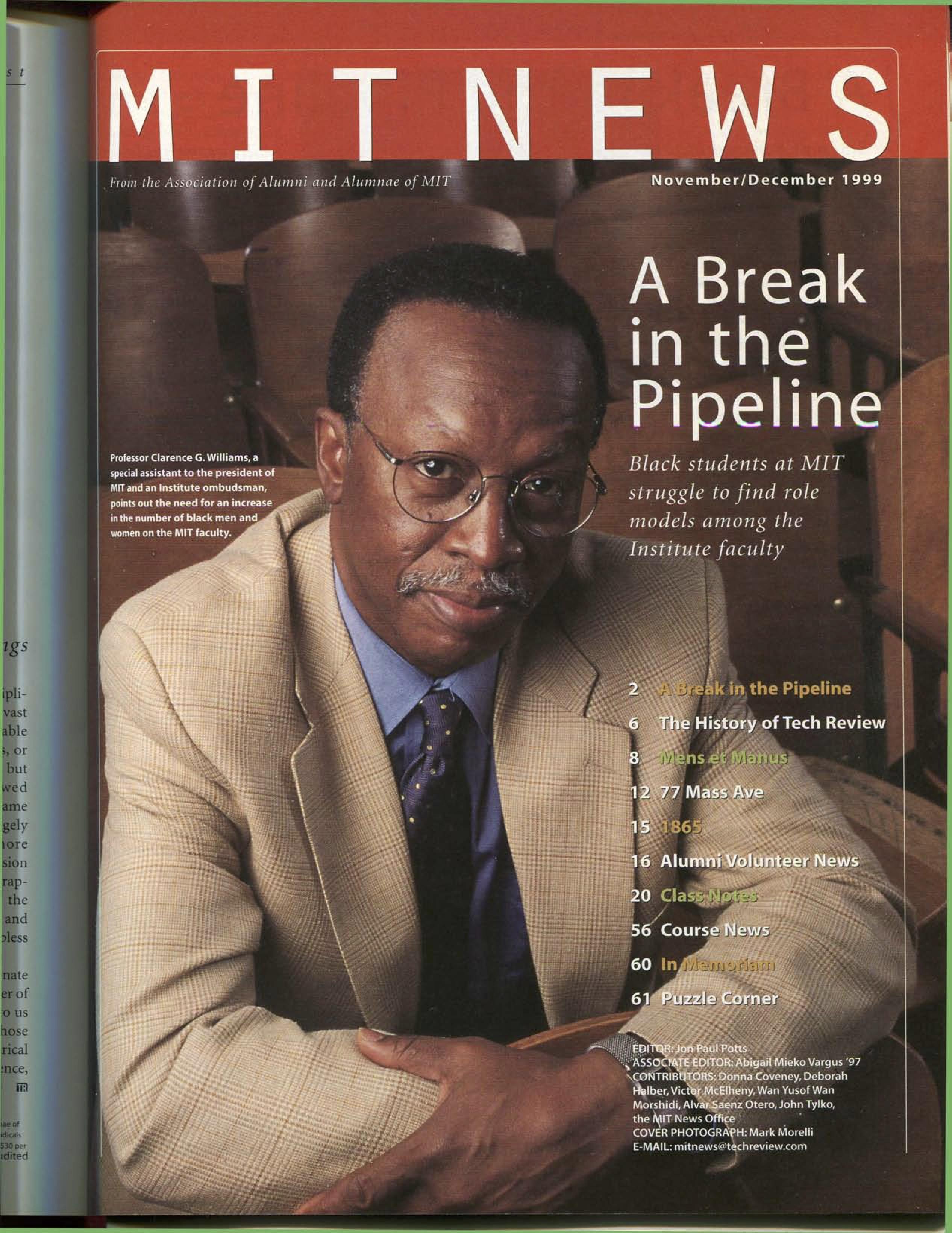
Image source: MIT Technology Review, Nov/Dec 1999
By 1975 MIT had five tenured and 15 non-tenured black professors on faculty; 6 tenured and 12 non-tenured in 1980; and 9 tenured and 7 non-tenured in 1981.
Marilyn Richardson - 1980
Marilyn Richardson joined the faculty as a lecturer in 1980 and taught courses in essay writing, fiction writing, women's studies, and African American Literature. She served as thesis advisor--along with history professor Kenneth Manning--to Dianna E. Abney '83 ("Notes on Researching Blacks at MIT prior to the Class of 1930").
In 1986, Richardson came up for a promotion and re-appointment review before a writing program committee, but was denied reappointment. Richardson charged that her case illustrates MIT's lack of action towards achieving its stated interest in a racially-integrated faculty:
While I will give credit to the Institute for its willingness to address racial problems in the Racial Climate at MIT report and others, the writing and literature departments at MIT have made less-than a good faith effort to recruit and keep such minority faculty as they once recruited.The Tech (14 Feb. 1989)
Richardson was active in the anti-Apartheid movement on campus. A writer and curator, she also pioneered a Black Women Writers Reading Series and helped organize a Prominent Black Bostonians photography exhibit at the Boston Athenaeum. She is the editor of Maria W. Stewart: America's First Black Woman Political Writer: Essays and Speeches (Blacks in the Diaspora) (Indiana University Press, 1987).
Richardson taught at MIT under various appointments until 1998.
TENURED BLACK PROFESSORS AT MIT - 1995
In 1988, MIT president Paul E. Gray '54, SM '55, ScD '60 lamented not having reached his goal of greater faculty diversity in the better part of the decade. By 1989, there had been a 50-percent drop in black MIT faculty and a decline in black graduate students since the 1970s.
The numbers appeared to increase by 1995, when the Journal of Blacks in Higher Education ran an article entitled The Serious Search for Black Faculty at MIT. Professors featured in the article were:
- Phillip L. Clay - Urban Studies and Planning
- Daniel Hastings - Aeronautics and Astronautics
- Willard R. Johnson - Political Science
- Kenneth R. Manning - History
- F. Dale Morgan - Earth, Atmospheric, and Planetary Science
- Marcus A. Thompson - Music & Theater Arts
- Cardinal Warde - Physics
- James H. Williams, Jr. - Mechanical Engineering
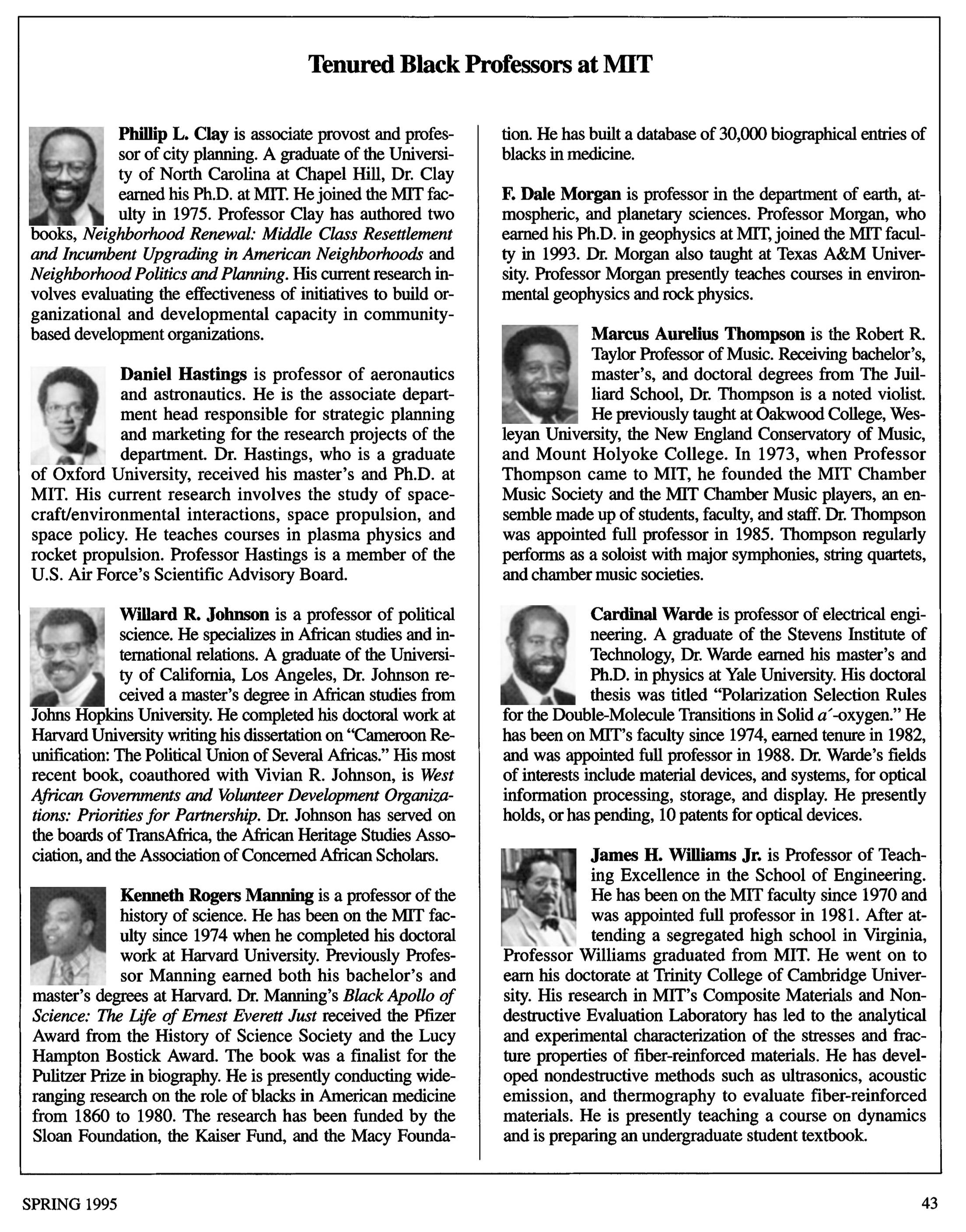
In 2000, Gray's successor as MIT president, Charles M. Vest, appointed an Institute-wide Council on Faculty Diversity “charged with formulating plans for the recruitment and advancement of women and minority faculty throughout the Institute.” Then rising MIT Chancellor Phillip L. Clay PhD ‘75, former Head of Urban Studies and Planning, served as co-chair. But by 2004, President Vest, like his predecessor, expressed regrets about not having achieved more diversity among professors and graduate students during his 14 years as MIT president.
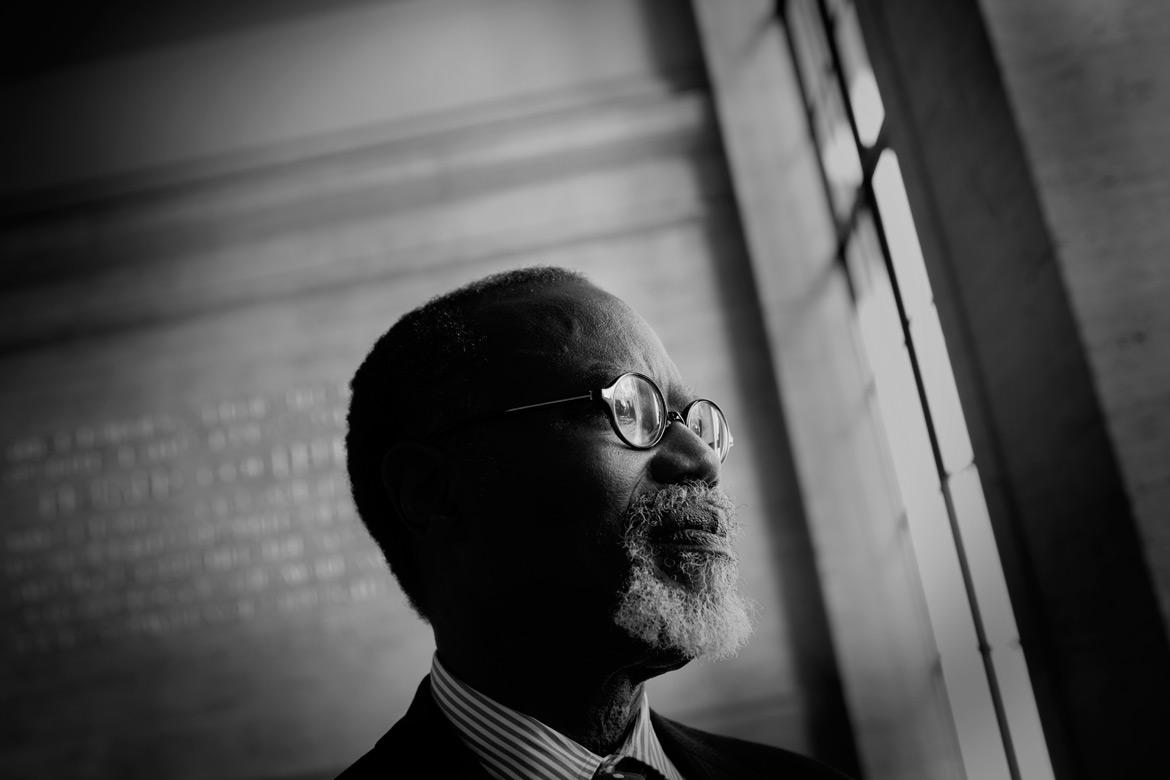
Photo: M. Scott Brauer/MIT News Office
Between 1984 and 2007, the Institute was plagued by a series of widely publicized tenure and hiring controversies involving black faculty members. (Coincidentally, five of the faculty hiring controversies at MIT involved black professors named James.)
HIRING CONTROVERSIES - 1984 to 2007
James E. Hubbard, Jr.
James Edward Hubbard, Jr. ’77, ME '79, Ph.D. ’82 grew up in segregated Virginia, where his mother was jailed for her involvement in the Civil Rights movement during the 1960s. Hubbard earned his undergraduate and graduate degrees from the Institute, becoming MIT's first black Ph.D. in mechanical engineering in 1982.
MIT invited Hubbard to join the faculty of the Mechanical Engineering Department and conduct research in the area of active vibration control of structures. From 1981 to 1985, Hubbard served as Assistant Professor, earning a Goodwin Medal for his exceptional teaching. His research at MIT involved parametric wind tunnel tests to investigate helicopter aero-acoustics. His work would later result in the production of what many consider the first example of an “adaptive structure” (able to respond to changes in its environment); he would also receive a patent for his work with “Smart Skin” sensor technology. A Fellow of the Vertical Flight Foundation, Hubbard was selected as a NASA Astronaut Candidate in 1984, the year before he left MIT.
I was a black student who was born, weaned, bred, and brought on to the [MIT] faculty. None of it would have been possible if I hadn't had the complete and enthusiastic support of the whole black community..."the tribe" banded together to raise the child.
James Hubbard, Jr. in Technology and the Dream, 1998
Hubbard is currently the University of Maryland Samuel P. Langley Professor and Director for the Center of Adaptive Aerospace Vehicle Technology at NASA's National Institute of Aerospace. In 2016, he was elected to the National Academy of Engineering, the first to be inducted for advances in adaptive structures.
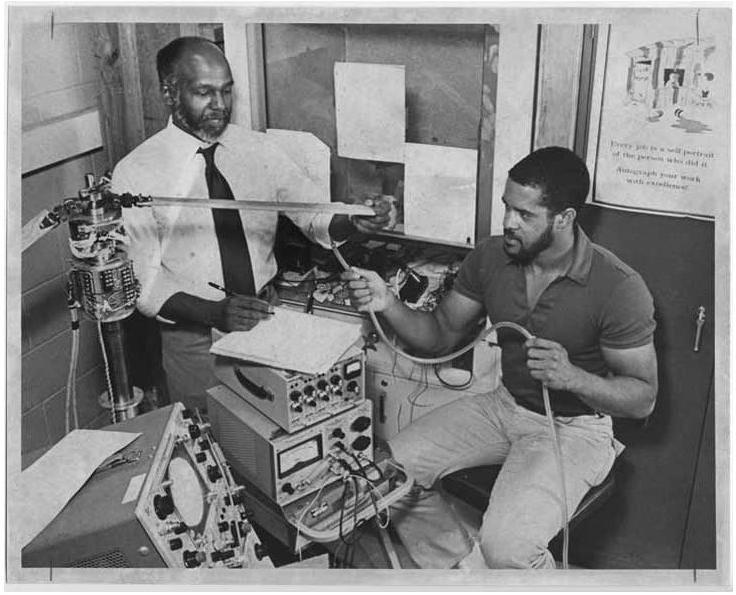
Photo: Calvin Campbell, courtesy MIT Museum
Jim Hubbard on why he left MIT
I was brought to MIT by Clarence [Williams, then Special Assistant to the President for Minority Affairs,] who came to Baltimore to recruit me. Fresh back from Vietnam, I had no interest or knowledge of MIT except through him. Coming to MIT this way, I had the support of the entire Black Faculty and Staff as well as the community at large. One of my three mentors (Wes Harris, Herb Richardson and Don Fraser) was my Department Chair and so again I was groomed, nurtured, and encouraged by my entire Department. In fact, he told me about a month ago that he had hopes that I would stay and become the Department Head one day. My fight there was with one person who was the Dean at the time and after 4 years on the faculty he vetoed my Department's request for a promotion--not tenure but a promotion, I believe, to Associate without Tenure. At the time, my mother was diagnosed with terminal cancer, and I wearied of the fight and left MIT to care for her. She lived another 13 years, I'm pleased to say.
Leaving [MIT] was the best decision I ever made, as I worked in Industry, Government, and Academia and had a broad set of wonderful experiences. Decades later I found myself at Maryland with Jim [Gates] as a Distinguished Tenured Full Professor with a named Chair and a dream position. I don't go back to MIT for any reason and I don't miss it. I spend my time mentoring and rarely dwell on what happened there...
Make no doubt, mine was not a cake walk by any means. In fact the attacks continued for many years after I left MIT...[James Gates, Jr. and I] were Quantum Twins, and my experience outside my Department mirrors [his]. In fact, I was so bitter that I left academia for more than 25 years and never looked back.
S. James Gates, Jr.
Sylvester James "Jim" Gates, Jr. '73, Ph.D. '77 earned two bachelor degrees in Physics and in Mathematics in 1973 and his doctorate in 1977, all from MIT. Under thesis advisor James E. Young, Gates submitted MIT’s first thesis addressing supersymmetry. Gates's teaching career began in 1972, as s student summer calculus instructor at MIT. Between 1982 and 1984 he served as an assistant professor. He briefly returned to the Institute as a 2010-11 MLK Scholar Visiting Professor hosted by the Department of Physics.
As Gates was only two years into his appointment, tenure denial was not the reason he was compelled to resign in 1984. Rather, Gates asserts that his voluntary departure from MIT had to do with the gulf he perceived between the Institute's stated commitment to diversity versus its practice. The pressure to leave MIT was driven by his own internal principles after observing an absence of understanding on the part of Institute officers of what would make MIT attractive for him to stay.
I have always felt there is a reciprocity in a relationship with any institution that would hold me to its standards...MIT simply failed mine.
Jim Gates, 2016
Today Gates is a world-renowned theoretical physicist who serves as a University Regents Professor of Physics at the University of Maryland. He is especially well-known for using adinkras (West African geometric symbols) to develop graphical representations of supersymmetric algebras. In 2014, Gates was honored with a National Medal of Science.
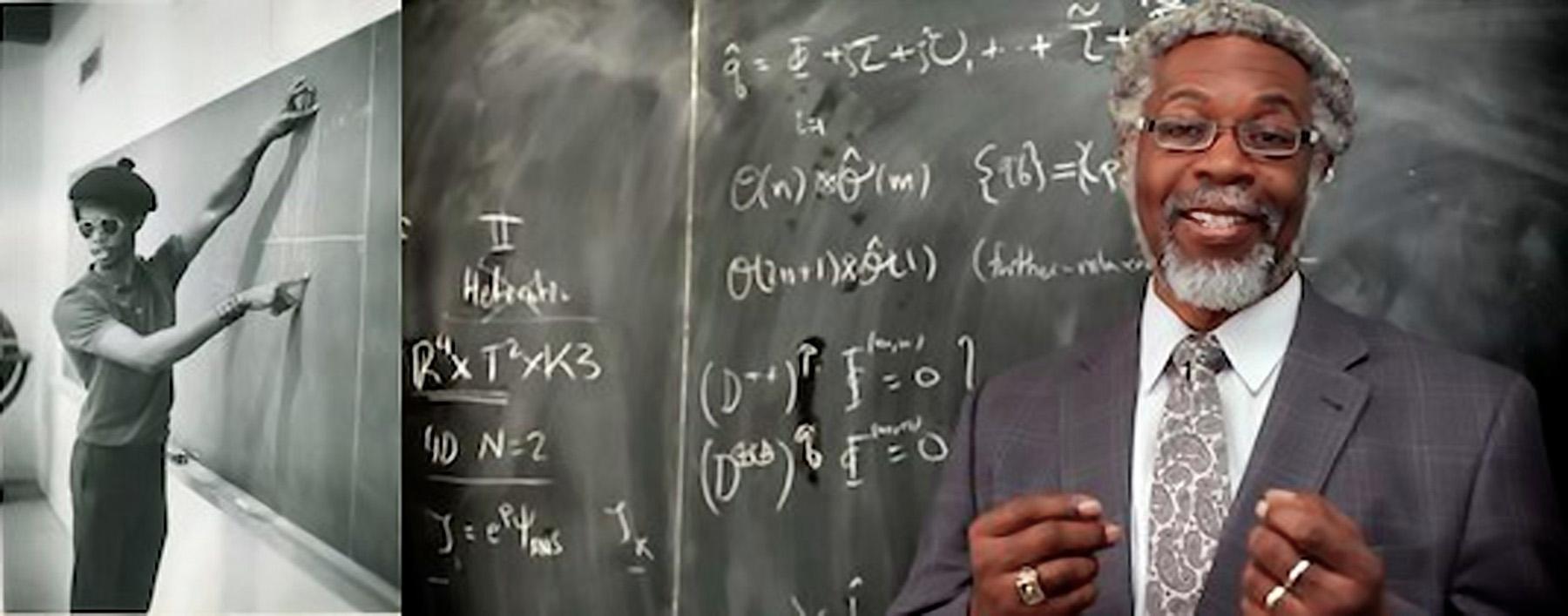
Sylvester James Gates, Jr. '73, PhD '77 (Physics). Left: As a Project Interphase instructor at MIT, 1972. Right: As a University Regents Professor of Physics at University of Maryland, 2014.
James H. Williams, Jr.
Each Wednesday throughout April of 1991, mechanical engineering professor James Henry Williams, Jr. '67, SM '68 sat working at a desk he had placed at the entrance of the Office of the MIT President and Provost. He was conducting a fasting sit-in to protest the lack of black faculty, along with a lack of inspirational education for minority students.
At the time, Williams was the only black professor in the combined School of Engineering and School of Science at MIT. He observed that the number of black faculty members had dwindled to about half of what it had been in the decade prior. In the MIT Faculty Newsletter piece, "Dilemmas, Colonialism, and Protest" (March 1991), Williams categorically lays out the motivation behind his protest. The sit-in drew widespread media attention and galvanized support from Institute colleagues, students, as well as members of the academic community, including black faculty members at Harvard.
At MIT my twoness, a professor and a black professor, has been honed into antagonistic strivings rather than complementary ideals; each appearing at odds with the other, each imposing major risks of invisibility upon the other. It didn't have to be so.
James Williams, MIT Faculty Newsletter, 1991
James Jennings
In 1992, political scientist James Jennings held a visiting appointment in the Department of Urban Studies and Planning. In 1996, MIT offered him a position as director of MIT’s Community Fellows Program, which trains Black and Latino grassroots activists. Jennings, however, was already tenured at the University of Massachusetts-Boston. That the MIT position came without reciprocal tenure was an insult to Jennings, and he rejected the offer. He learned from a faculty member that the senior search committee had faulted him for not being among the nation’s top three black scholars. In response, Jenning took his complaint to the Massachusetts Commission Against Discrimination, which ruled in his favor. But before he could take the suit to court, the case was settled out of court. Jennings eventually earned tenure at Tufts University, where he is now Professor Emeritus of Urban and Environmental Policy and Planning.
[T]he fiasco around the handling of the James Jennings situation is an example of...elitism that ill-serves MIT. It was institutional racism...that was distressing.
Herbert E. Jones, MIT Professor of Urban Studies and Planning, in Technology and the Dream, 1998
James L. Sherley
Sixteen years after James H. Williams, Jr. '67, SM '68 conducted a fasting sit-in to protest the lack of black faculty at MIT, another James stationed himself at the entrance of the Provost's Office in protest.
On February 5, 2007, biological engineering Professor James L. Sherley began a 12-day hunger strike on campus to protest the Biological Engineering (BE) Department’s decision not to promote him to tenure. He sat from 9 am to noon for twelve days, subsisting on water, electrolytes, and vitamin supplements. Surrounded by media and supporters, Sherley called for MIT to:
- Grant him immediate tenure,
- Begin "a verifiable process to detect and redress racism in treatment and tenure promotion of minority faculty," and
- Censure the provost for obstruction of "a fair and diligent investigation".
Sherley, one of 23 MIT black professors at the time, was outspoken against human embryonic stem cell research, believing that cloning them was unethical. His research instead focused on adult stem cells and their molecular and biochemical mechanisms. But at MIT, Sherley stated in his "Plea to end racism at MIT," BE had granted him neither the proper laboratory space nor the freedom to advance his research.
They might tolerate and even celebrate such a challenge [to scientific orthodoxy] from a white faculty member, but never from one who is black.
James Sherley, "Plea to end racism at MIT," 2006
The controversy prompted heated debate within the MIT community and throughout academia. A colleague resigned in protest, and an alum withdrew Institute support. After 12 days, Sherley ended his hunger strike without MIT having met any of his demands. He was barred from his office with locked doors on June 30, 2007.
ASSOCIATE PROVOST FOR FACULTY EQUITY- 2008
In 2008, Wesley "Wes" L. Harris, the Charles Stark Draper Professor of Aeronautics and Astronautics, was appointed Associate Provost for Faculty Equity. Harris served as the first director of MIT's Office of Minority Education (1975-79) and as Head of the Department of Aeronautics and Astronautics (2003-08). He was honored with the 2014 MIT Dr. Martin Luther King, Jr. Lifetime Achievement Award for his ongoing commitment to student academic achievement and for his work on increasing faculty diversity efforts. His interview for MIT's Infinite History Project offers penetrating insight into the importance of diversity at the Institute and in the United States.
FACULTY DIVERSITY REPORT - 2010
In 2010, MIT issued a Report on The Initiative for Faculty Race and Diversity on how race affects the recruitment, retention, professional opportunities, and collegial experiences of minority professors at MIT.
The original impetus for this report stems from a unanimous 2004 resolution of the MIT faculty to double the percentage of URM faculty (and triple the percentage of URM graduate students) within ten years. The faculty adopted this resolution in recognition of MIT's commitment "to developing and maintaining a robust environment that values and celebrates the potential of all the members of the MIT community as that potential enhances MIT's mission to continued excellence in teaching, research, and community service."
President L. Rafael Reif, Letter to the Community, 14 January 2010
Chemical Engineering Professor Paula T. Hammond ’84, PhD ’93 led the report committee, which included Emery N. Brown of the School of Science; Leslie K. Norford of the School of Architecture and Planning; Christine Ortiz of the School of Engineering; Marcus A. Thompson of the School of Humanities, Arts, and Social Sciences; and Lotte Bailyn of the Sloan School. In developing the Initiative, MIT drew from its experiences with the 1999 Study on the Status of Women Faculty in Science at MIT.
Some Key Findings by the Initiative
- MIT recruits heavily from its own departments and from a few peer institutions- broadening the recruitment search could yield larger numbers of URM faculty.
- Compared to their White peers, a higher percentage of URM faculty leave before or after they are promoted to associate professor without tenure- efforts to retain URM faculty may be especially critical in their first 3-5 years.
- Poor or negative faculty mentoring experiences are more frequent for URM than for non-URM faculty- mentoring across the Institute lacks consistency.
- Overall, URM faculty report more dissatisfaction than their White counterparts- URM non-tenured faculty, particularly black faculty, are most likely to be “very satisfied” with their lives at MIT.
- There is “great awkwardness” in addressing race and racial differences openly at MIT- discussion of race-related issues is avoided.
Some Recommendations by the Initiative
- Each academic unit should work with its academic dean and the associate provost of faculty equity on strategies for improving URM faculty recruitment efforts.
- Department heads and faculty search chairs must be responsible for improving URM faculty recruiting.
- Formal mentors should be assigned to junior faculty hires; mentors and mentees should be informed about expectations.
- Annual reviews should be implemented for each junior faculty member beginning in their first year of employment.
- MIT should broaden faculty searches to other carefully selected institutions.
- MIT should create forums where race and cross-cultural interactions are openly discussed; the Institute should harness its most highly respected scholars, scientists, and engineers to act as spokespeople on diversity issues.

Faculty Diversity Report word cloud
FACULTY TRIFECTA - 2015
In 2015, MIT made unprecedented back-to-back appointments of three black faculty members.
During the 2015 MIT Alumni Leadership Conference, the Black Alumni/ae of MIT (BAMIT) gathered colleagues and friends to pay tribute to the promotion of three distinguished professors: Paula T. Hammond '84, Ph.D. '93; Melissa Nobles; and Marcus A. Thompson. The event was covered in Black Enterprise magazine.
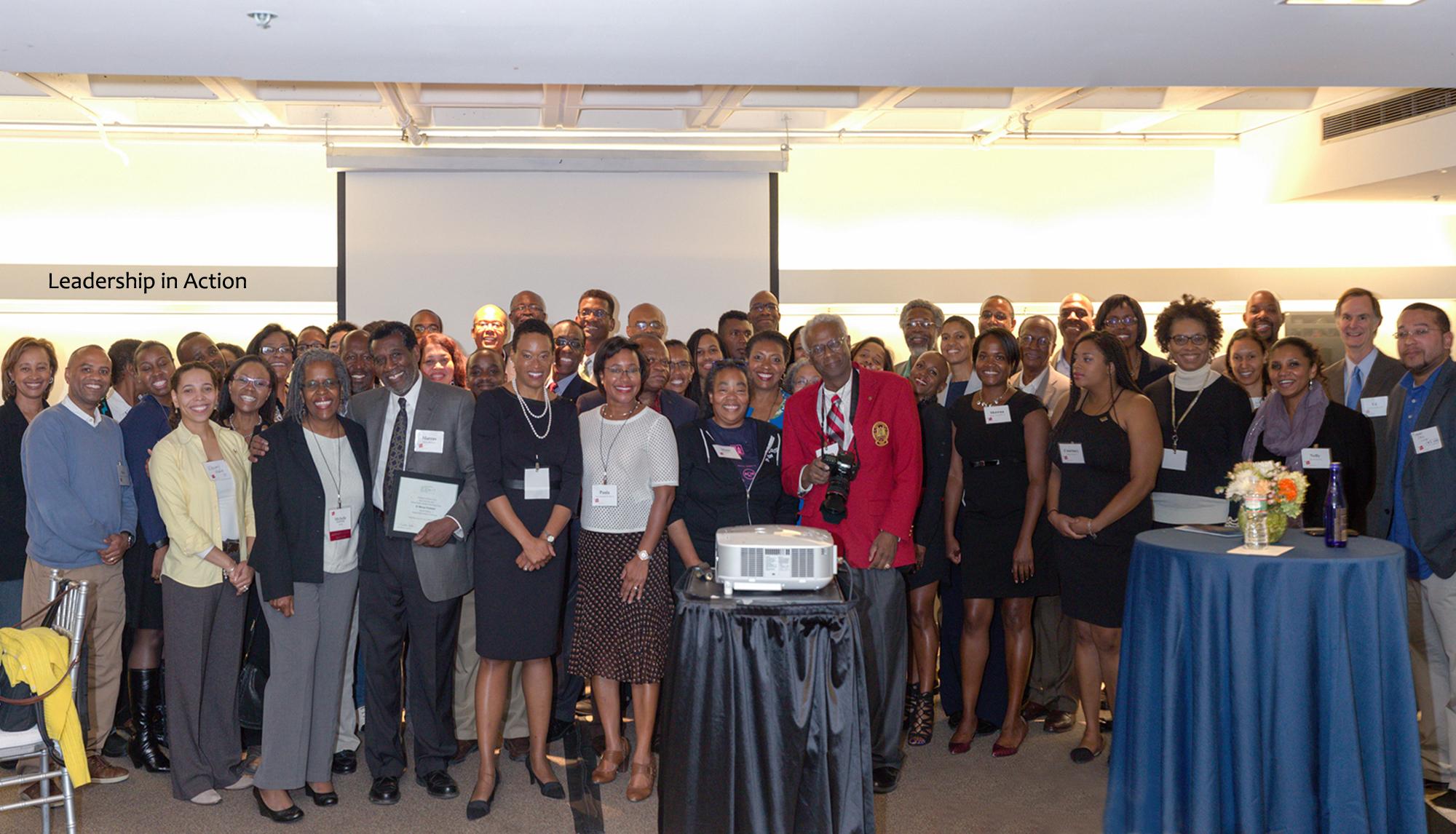
BAMIT Black Faculty Reception at MIT ALC honoring professors Marcus Thompson, Melissa Nobles, and Paula Hammond (front row, 4th-6th from left, respectively), September 2015.
Paula T. Hammond: Head of the Chemical Engineering
Detroit native Paula Therese Hammond '84, Ph.D. '93 was appointed Head of the Chemical Engineering Department. She is the first MIT graduate, first woman, and the first person of color to become head of an MIT academic department in the School of Engineering. A David H. Koch Professor at the David H. Koch Institute for Integrative Cancer Research and the Department of Chemical Engineering, Hammond has been a member of the MIT faculty since 1995. Her research focuses on macromolecular design and synthesis, targeted drug delivery for cancer, nanoscale assembly of synthetic biomaterials, and electrostatic and directed materials assembly.
[Hammond] has a deep knowledge of the Institute and has led a remarkable career as a researcher and educator.
Ian A. Waiz, Dean of the School of Engineering
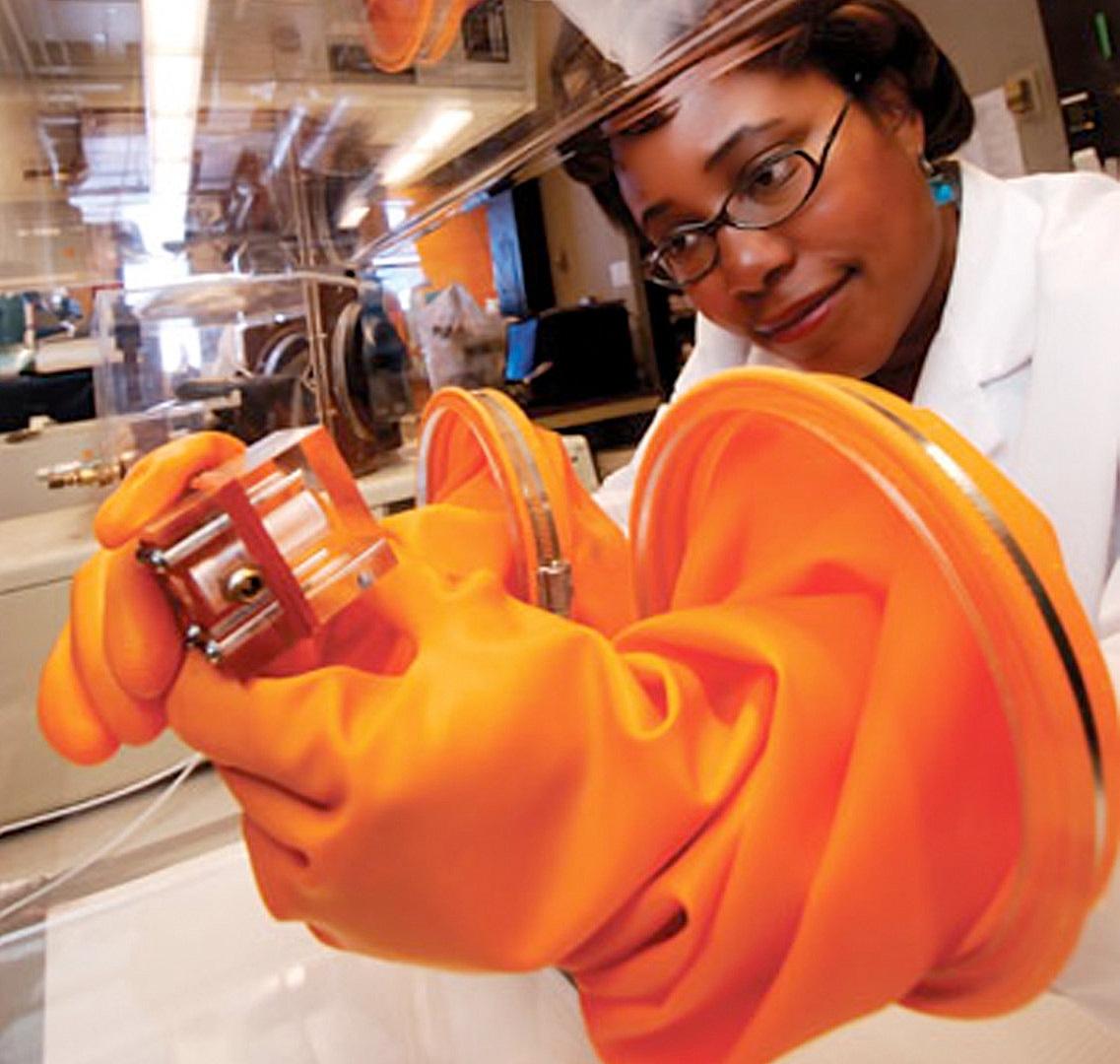
Chemical engineering professor Paula Hammond works a small-scale experimental fuel cell under tightly controlled conditions, 2007.
Melissa Nobles: Dean of the School of Humanities, Arts, and Social Sciences
Harlem-born Melissa Nobles was named Kenan Sahin Dean of the School of Humanities, Arts, and Social Sciences at MIT (SHASS), the first black dean of one of the five academic schools. A member of the MIT faculty since 1995, Nobles has been the Arthur and Ruth Sloan Professor of Political Science since 2010 and served as head of MIT’s Department of Political Science until 2013. Her research focuses on comparative studies of racial and ethnic politics and issues of retrospective justice.
[Nobles offers MIT] a vision of the humanities, arts, and social sciences as the human stage on which our scientific and technical solutions have purpose and meaning.
L. Rafael Reif, MIT President
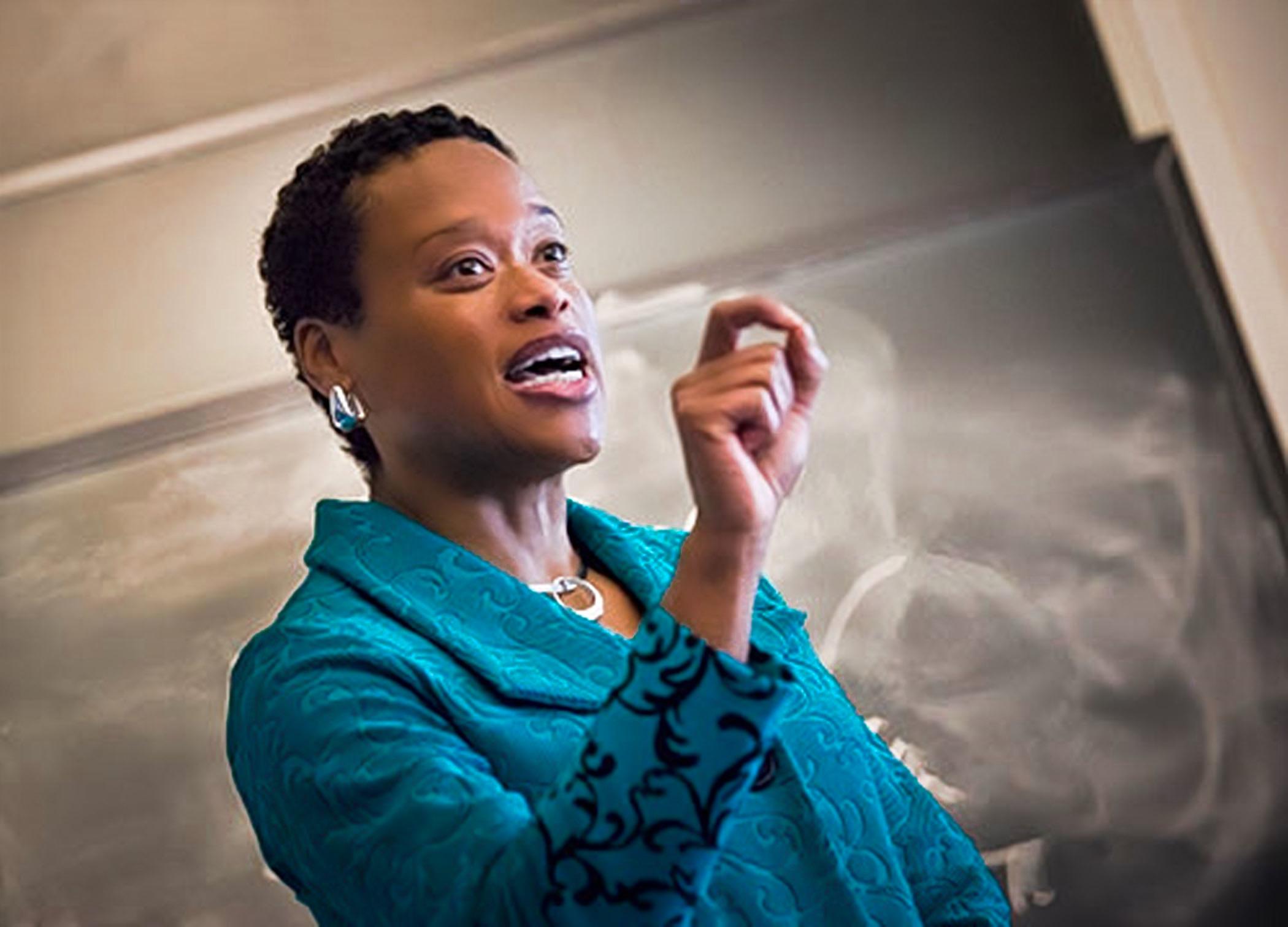
Melissa Nobles, Kenan Sahin Dean of the School of Humanities, Arts, and Social Sciences at MIT (SHASS)
Marcus A. Thompson: Institute Professor
Bronx native Marcus Aurelius Thompson became the first black professor to earn MIT’s highest faculty honor: Institute Professor. He joins a small group of Institute Professors at MIT, now numbering 13, along with 10 Institute Professors Emeriti. Thompson is one of three faculty members to be named Institute Professors since 2008. Trained at Julliard, Thompson is an internationally acclaimed violist and chamber music player. His arrival to MIT as an assistant professor of music in 1973 was later followed by his inaugural appointment in 1995 as the Robert R. Taylor Professor of Music (a professorship named after MIT's first black graduate, Robert R. Taylor, Class of 1892), as well as being named a Margaret MacVicar Faculty Fellow for exceptional teaching. After over four decades, Thompson continues to be an influential presence at the Institute.
Over his long career, Marcus has worked to give students access to a world-class music program that has changed MIT.
Steven Hall, Professor of Aeronautics and Astronautics and MIT Faculty Chair

Marcus A. Thompson, Institute Professor
FACULTY INTERVIEWS - 2012 to Present
Since 2012, the MIT Black History Project has been conducting video interviews of tenured black MIT professors. These oral histories explore the life experiences, including the successes and challenges faced, along the journey to becoming faculty. As of 2014, a dozen faculty members across departments have been interviewed, with additional interviews planned.
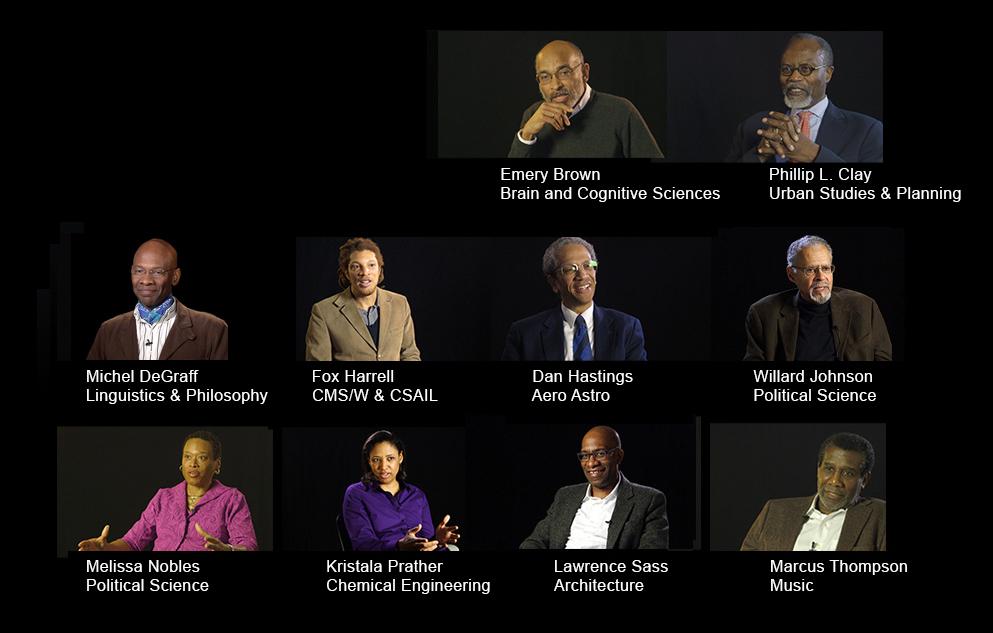
Tenured faculty interviewed by the MIT Black History Project
